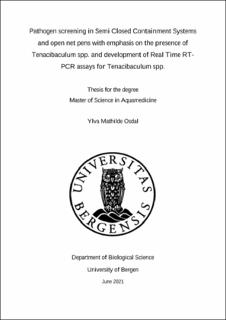| dc.contributor.author | Osdal, Ylva Mathilde | |
| dc.date.accessioned | 2021-06-25T07:13:31Z | |
| dc.date.issued | 2021-06-07 | |
| dc.date.submitted | 2021-06-24T22:00:33Z | |
| dc.identifier.uri | https://hdl.handle.net/11250/2761262 | |
| dc.description.abstract | Tenacibaculosis, caused by Tenacibaculum spp., has been an increasing problem in Norwegian Salmon farming causing reduced fish welfare and significant economic losses. Semi Closed Containment System (SCCS) is a rather new technology that have proved effective against sea lice, however its preventive effect on pathogens such as Tenacibaculum spp. has not yet been assessed. The aim of this study was to investigate whether a SCCS could reduce the presence of Tenacibaculum spp. associated with ulcerative disease compared to a traditional open net pen. A secondary aim was to establish Real Time RT-PCR assays to differentiate Clade I, II and III of Tenacibaculum spp. relevant to ulcerative disease in Norway. Three Real Time RT-PCR assays were developed in this study: TffC3 targeting Tenacibaculum finnmarkense genomovar finnmarkense (Clade III), TfuC1 targeting T enacibaculum finnmarkense genomovar ulcerans (Clade I) and TdC2 targeting Tenacibaculum dicentrarchi (Clade II). Testing of the assays confirmed that they were specific, sensitive and effective in detecting the target bacteria when using a reverse transcriptase and annealing temperature of 47 °C and 62 °C, respectively. The assays were used in pathogen screening of fish- and water samples from the SCCS and open net pen in this study. A previously developed assay targeting the bacterium Moritella viscosa (‘typical’ and ‘variant’) was also included in this screening as it is commonly found in skin lesions/ulcers in outbreaks of ‘winter ulcers’. Fish- (1-111 dps) and water samples (1-170 dps) were collected from the SCCS and open net pen at the study site with more frequent samplings during the first month post stocking as this is the period in which the risk of tenacibaculosis is at its highest. Fish tissue sampled from the skin and gills, and water samples were analyzed using the developed Real Time RT-PCR assays. The results showed that there was a significantly higher presence of T. finnmarkense fish from the open net pen compared to the SCCS when considering the gill tissue. It is concluded that T. dicentrarchi is likely not present in Northern Norway salmon farms and thus can be omitted from screening of outbreaks of ulcerative disease in the Northern Norway. T. finnmarkense is always present in the water 1-170 dps, while M. viscosa emerge in the water concurrent with the onset of ulcerative disease. | |
| dc.language.iso | eng | |
| dc.publisher | The University of Bergen | |
| dc.rights | Copyright the Author. All rights reserved | |
| dc.subject | Tenacibaculum dicentrarchi | |
| dc.subject | Tenacibaculum finnmarkense | |
| dc.subject | Pathogen screening | |
| dc.subject | tenacibaculosis | |
| dc.subject | Semi Closed Containment System | |
| dc.subject | Moritella viscosa | |
| dc.subject | Real Time RT-PCR | |
| dc.subject | water sample | |
| dc.subject | 'winter ulcer disease' | |
| dc.title | Pathogen screening in Semi Closed Containment Systems and open net pens with emphasis on the presence of Tenacibaculum spp. and development of Real Time RT- PCR assays for Tenacibaculum spp. | |
| dc.type | Master thesis | |
| dc.date.updated | 2021-06-24T22:00:33Z | |
| dc.rights.holder | Copyright the Author. All rights reserved | |
| dc.description.degree | Masteroppgave i fiskehelse | |
| dc.description.localcode | FISK399 | |
| dc.description.localcode | MAMN-FISK | |
| dc.subject.nus | 759906 | |
| fs.subjectcode | FISK399 | |
| fs.unitcode | 12-60-0 | |
| dc.date.embargoenddate | 2022-06-02 | |
